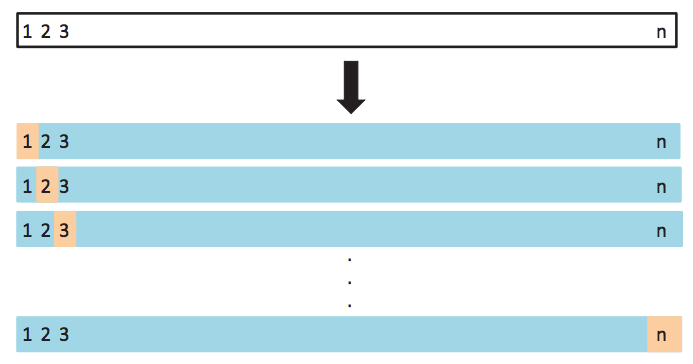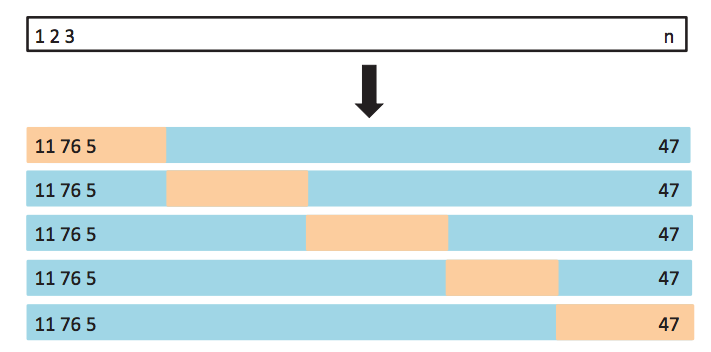32 Model Selection
Our discussion on regression and classification has been centered on fitting models by minizing error or maximizing likelihood given a dataset (also referred to as training data). This is usually fine when we want to use our model for explanatory or inferential tasks. Or when we use relatively inflexible models, like linear regression or logistic regression. However, as our interests shift to prediction and more complex models, like non-linear regression, Tree-based methods or Support Vector Machines, this is usually not sufficient.
In these cases, our goal is to avoid building models that are too specific for the dataset we have on hand. Complex models can easily overfit our training data, in which case we don’t learn much about the population from which we obtain the training data and instead learn only about the training data itself. We say that we want to learn, or train models that generalize beyond the training data to other, unseen, data from the same population.
This leads to a bit of an issue. How do we measure our models ability to predict unseen data, when we only have access to training data?
32.1 Cross Validation
The most common method to evaluate model generalization performance is cross-validation. It is used in two essential data analysis phases: Model Selection and Model Assessment.
In Model Selection, we decide how complex of a model we should fit. Consider a linear regression example: I will fit a linear regression model, what predictors should be included?, interactions?, data transformations? Another example is what classification tree depth to use.
In Model Assessment, we determine how well does our selected model performs as a general model. Example: I’ve built a linear regression models, with specific predictors. How well will it perform on unseen data? The same question can be asked of a classification tree (of specific depth).
Cross-validation is a resampling method to obtain estimates of test error rate (or any other performance measure on unseen data). In some instances, you will have a large predefined test dataset that you should never use when training. In the absence of access to this kind of dataset, cross validation can be used.
32.2 Validation Set
The simplest option to use cross-validation is to create a validation set, where our dataset is randomly divided into training and validation sets. Then the validation is set aside, and not used at until until we are ready to compute test error rate (once, don’t go back and check if you can improve it).

Let’s look at our running example using automobile data, where we want to build a regression model capable of predicting miles per gallon given other auto attributes. We saw in previous lectures that a linear regression model was not appropriate for this dataset. So instead we will use polynomial regression as an illustrative example.
library(ggplot2)
library(ISLR)
data(Auto)
ggplot(Auto, aes(x=horsepower, y=mpg)) + geom_point() + geom_smooth()In this case our regression model (for a single predictor \(x\)) is given as a \(d\) degree polynomial.
\[ \mathbb{E}[Y|X=x] = \beta_0 + \beta_1 x + \beta_2 x^2 + \cdots + \beta_d x^d \]
In the Model Selection case, we want to decide what degree \(d\) we should use to model this data. Using the validation set method, we split our data into a training set, fit the regression model with different polynomial degrees \(d\) on the training set, and measure test error on the validation set.
set.seed(1234)
in_validation <- sample(nrow(Auto), nrow(Auto)/2)
validation_set <- Auto[in_validation,]
training_set <- Auto[-in_validation,]
library(broom)
library(dplyr)
degrees <- seq(1, 10)
error_rates <- sapply(degrees, function(deg) {
fit <- lm(mpg~poly(horsepower, degree=deg), data=training_set)
predicted <- predict(fit, newdata=validation_set)
mean((validation_set$mpg - predicted)^2)
})
plot(degrees, error_rates, type="b", xlab="Polynomial Degree", ylab="Mean Squared Error", pch=19, lwd=1.4, cex=1.4)32.3 Resampled validation set
This approach can be prone to sampling issues. It can be highly variable as error rate is a random quantity and depends on observations in training and validation sets. We can improve our estimate of test error by averaging multiple measurements of it (remember the law of large numbers). We can do so by replicating our validation resampling 10 times (with different validation and training sets) and averaging the resulting test errors.
32.4 Leave-one-out Cross-Validation
This approach still has some issues. Each of the training sets in our validation approach only uses 50% of data to train, which leads to models that may not perform as well as models trained with the full dataset and thus we can overestimate error. To alleviate this situation, we can extend our approach to the extreme. Make each single training point it’s own validation set.
Procedure:
For each observation \(i\) in data set:
a. Train model on all but \(i\)-th observation
b. Predict response for \(i\)-th observation
c. Calculate prediction error
This gives us the following cross-validation estimate of error.
\[ CV_{(n)} = \frac{1}{n} \sum_i (y_i - \hat{y}_i)^2 \]

The advantages of this approach is that now we use \(n-1\) observations to train each model and there is no randomness introduced since error is estimated on each sample. However, it has disadvantages as well. Depending on the models we are trying to fit, it can be very costly to train \(n-1\) models. Also, the error estimate for each model is highly variable (since it comes from a single datapoint).
For linear models (and some non-linear models) there is a nice trick that allows one to compute (exactly or approximately) LOOCV from the full data model fit which we will not get into here.
32.5 k-fold Cross-Validation
This discussion leads us to the most commonly used cross-validation approach k-fold Cross-Validation.
Procedure:
Partition observations randomly into \(k\) groups (folds).
For each of the \(k\) groups of observations:
- Train model on observations in the other \(k-1\) folds
- Estimate test-set error (e.g., Mean Squared Error)
Compute average error across \(k\) folds

\[ CV_{(k)} = \frac{1}{k} \sum_i MSE_i \]
where \(MSE_i\) is mean squared error estimated on the \(i\)-th fold
In this case, we have fewer models to fit (only \(k\) of them), and there is less variance in each of the computed test error estimates in each fold. It can be shown that there is a slight bias (over estimating usually) in error estimate obtained from this procedure.
32.6 Cross-Validation in Classification
Each of these procedures can be used for classification as well. In this case we would substitute MSE with performance metric of choice. E.g., error rate, accuracy, TPR, FPR, AUROC. Note however that not all of these work with LOOCV (e.g. AUROC since it can’t be defined over single data points).
32.7 Comparing models using cross-validation
Suppose you want to compare two classification models (logistic regression vs. a decision tree) on the Default dataset. We can use Cross-Validation to determine if one model is better than the other, using a paired \(t\)-test for example.
library(ISLR)
library(cvTools)
library(tree)
data(Default)
fold_indices <- cvFolds(n=nrow(Default), K=10)
error_rates <- sapply(1:10, function(fold_index) {
test_indices <- which(fold_indices$which == fold_index)
test_set <- Default[test_indices,]
train_set <- Default[-test_indices,]
logis_fit <- glm(default~., data=train_set, family="binomial")
logis_pred <- ifelse(predict(logis_fit, newdata=test_set, type="response") > 0.5, "Yes", "No")
logis_error <- mean(test_set$default != logis_pred)
tree_fit <- tree(default~., data=train_set)
pruned_tree <- prune.tree(tree_fit, best=3)
tree_pred <- predict(pruned_tree, newdata=test_set, type="class")
tree_error <- mean(test_set$default != tree_pred)
c(logis_error, tree_error)
})
rownames(error_rates) <- c("logis", "tree")
error_rates <- as.data.frame(t(error_rates))
library(tidyr)
library(dplyr)
error_rates <- error_rates %>%
mutate(fold=1:n()) %>%
gather(method,error,-fold)
error_rates %>%
head() %>%
knitr::kable("html")| fold | method | error |
|---|---|---|
| 1 | logis | 0.028 |
| 2 | logis | 0.037 |
| 3 | logis | 0.021 |
| 4 | logis | 0.030 |
| 5 | logis | 0.029 |
| 6 | logis | 0.018 |
| term | estimate | std.error | statistic | p.value |
|---|---|---|---|---|
| (Intercept) | 0.0267 | 0.0020306 | 13.148828 | 0.0000000 |
| methodtree | 0.0030 | 0.0028717 | 1.044677 | 0.3099998 |
In this case, we do not observe any significant difference between these methods.
32.8 Summary
Model selection and assessment are critical steps of data analysis. Resampling methods are general tools used for this purpose.